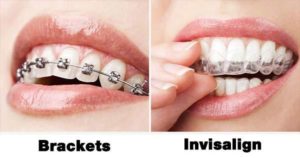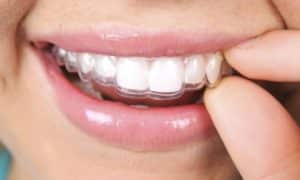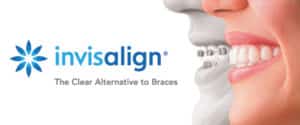Invisalign was founded by former adult orthodontic patient Zia Chishti, who was a Stanford student, struggling with his retainer. He realized that most dental orthodontics could be done the same way – in a series of very small movements. He partnered with Kelsey Wirth to seek developers.
The company received FDA approval in 1998 and sales began in 1999. While many orthodontists were against the idea at first, high consumer demand and obvious results soon made this brand become one of the most popular among dentists.
The company, Align Technology, went public on the NASDAQ in 2001 under the ticker symbol ALGN.  As of 2014, Align Technology states that at least 2.4 million people around the world had been treated with Invisalign, and 80,000 dentists had been trained how to use it.
As of 2014, Align Technology states that at least 2.4 million people around the world had been treated with Invisalign, and 80,000 dentists had been trained how to use it.
The Invisalign Express 10, which uses 10 aligners, was introduced in 2005. Invisalign 1.5 was released in 2009, followed by Invisalign G3 in 2010 and G4 in 2011. Invisalign G3 and G4 were designed for more complex treatments. An Invisalign Express 5 version, which uses 5 aligners, was introduced in 2012. Invisaligners are manufactured in Mexico, with treatment plans being made in Costa Rica.
Also in 2005, Harvard School of Dental Medicine began requiring that its orthodontic graduate students complete Invisalign certification before they graduate.
Aligners are made from a molding cast, which clients can make at home or at a dental office. Aligners are then worn by the patient for 20 hours a day, each aligner lasting about 2 weeks before moving on to the next aligner. Most patients will take about 13 months to complete the treatment. Long lasting “retainers” are worn each night for a minimum of 2 years. 
In March of 2011, the company acquired Cadent System, Inc., a dental firm, for $190 million. The company also operates separate subsidiaries in Hong Kong and Australia that sell Invisalign in their respective markets. Headquarters for Invisalign is still located in San Jose, California.
Invisalign
Invisalign was founded by former adult orthodontic patient Zia Chishti, who was a Stanford student, struggling with his retainer. He realized that most dental orthodontics could be done the same way – in a series of very small movements. He partnered with Kelsey Wirth to seek developers.
The company received FDA approval in 1998 and sales began in 1999. While many orthodontists were against the idea at first, high consumer demand and obvious results soon made this brand become one of the most popular among dentists.
History
The company, Align Technology, went public on the NASDAQ in 2001 under the ticker symbol ALGN.  As of 2014, Align Technology states that at least 2.4 million people around the world had been treated with Invisalign, and 80,000 dentists had been trained how to use it.
As of 2014, Align Technology states that at least 2.4 million people around the world had been treated with Invisalign, and 80,000 dentists had been trained how to use it.
The Invisalign Express 10, which uses 10 aligners, was introduced in 2005. Invisalign 1.5 was released in 2009, followed by Invisalign G3 in 2010 and G4 in 2011. Invisalign G3 and G4 were designed for more complex treatments. An Invisalign Express 5 version, which uses 5 aligners, was introduced in 2012. Invisaligners are manufactured in Mexico, with treatment plans being made in Costa Rica.
Also in 2005, Harvard School of Dental Medicine began requiring that its orthodontic graduate students complete Invisalign certification before they graduate.
Aligners are made from a molding cast, which clients can make at home or at a dental office. Aligners are then worn by the patient for 20 hours a day, each aligner lasting about 2 weeks before moving on to the next aligner. Most patients will take about 13 months to complete the treatment. Long lasting “retainers” are worn each night for a minimum of 2 years. 
In March of 2011, the company acquired Cadent System, Inc., a dental firm, for $190 million. The company also operates separate subsidiaries in Hong Kong and Australia that sell Invisalign in their respective markets. Headquarters for Invisalign is still located in San Jose, California.


I ordered Invisaline retainers they were to be for me grinding my teeth. I was told they would not move my teeth that this was just to keep them in the same place but allowing me not to grind my teeth. I have worn them for a month or so & my smile has been totally changed due to the retainers moved several of my teeth now giving me a very uncomfortable smile! This is NOT right! I feel it’s only right that you give me a pair of braces to fix this problem. I wish I could attach some photos I have the proof that my teeth have moved so much my smile is NOT the same. I spent $400 dollars for nothing. If you do not wish to work with me on this I will contact my attorney my teeth look horid!
I’d like to know how I can contact someone at corporate about a malpractice issue. I finished Invisalign in April and my teeth shifted a bit although they were still fitting in my final aligners. The doctor used a dumpling tool to “push” some teeth back in place and also did some shaving. Now my bottom teeth are jagged and uneven when they used to be straight. He has spent the last few weeks without giving me a straight answer. I need to talk to someone at corporate about how this happened. He said he is using “Invisalign sponsored” technology.
I am asking if it possible to cancel an order or put a hold on a order while a patient has oral surgery and does not know if they will be able to use Invisalign?
Thank you –
Lisa Katsman